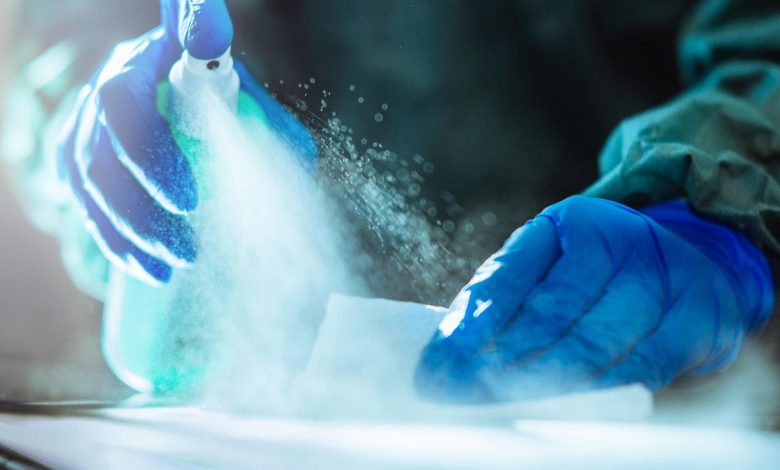Is There Hidden Mold in Your Home? Check These 7 Common Places

[ad_1]
Cleaning your home regularly is a good idea. Checking for mold while you’re at it? Even better. Don’t forget to add regular mold inspections to your cleaning to-do list. In fact, no this can be harmful to your health. As you probably already know, mold is a nasty fungus that can grow quickly and easily go unnoticed and spread over time if not removed immediately.
Unfortunately, your house can be a breeding ground for mold spores, especially if it is damp or if there have been leaks or floods. “Anywhere there’s potential for moisture, there’s potential for mold,” Loreen Burton, Chemist/Toxicologist at Environmental Protection AgencyDivision of Indoor Environment, told CNET.
We’ll help you discover where mold may be lurking in your house, as well as any signs to look out for. We will also explain all the steps you need to take to get rid of mold as soon as possible. Speaking of which, don’t let mold grow in your Keurig; here’s how to clean it.
Signs that mold may be in your house
Here are some clear signs that mold may be growing in your home. If you notice any of these signs, be sure to address the problem as soon as possible to prevent mold from spreading.

Musty smell: The smell of dirt in your house can be an indicator that there is mold.
Stains on the walls: If something is leaking — specifically water pipes in your walls or ceiling — you’ll likely see water stains (or water damage). If this is the case, mold can grow inside the walls.
Seeing visible mold: Mold can appear in a variety of colors and textures. For example, it can be black, white and even green and can be fuzzy or slimy.
Your allergies are getting worse: Mold can cause allergic reactions when you inhale the spores, according to the Asthma and Allergy Foundation of America. Symptoms can include congestion, coughing, runny nose and sneezing.
Common places mold can be hiding in your home
Mold can be found almost anywhere and can grow on anything as long as there is moisture. Here are some common areas where mold can be found in homes, according to the EPA’s Burton.
Air conditioners: If there is a build-up of moisture in your air conditioning units, it can create the perfect environment for mold to grow.
Attic rooms: Without proper ventilation, moisture can build up in your attic, which can cause mold.
Basement: Sometimes basements can be dark, damp and poorly ventilated — especially if there are no windows. And often, if there is flooding in the house, it is in the basement. This makes them a prime place for mold to grow.
Bathrooms: Check showers, bathtubs, sinks and toilets for mold. Bathrooms regularly accumulate moisture, which is an ideal environment for mold to grow.
Behind walls: If a pipe bursts or even leaks, mold can develop without you knowing. Make sure you fix the leaks immediately and clean up the spill.
Kitchens: Mold can grow in places in kitchens where there is plumbing, including under the sink if there is a leak, and around refrigerators and dishwashers.
Laundry facilities: Washing machines can be a favorable environment for mold growth (here’s how to kill mold in your washing machine), as well as sinks in your laundry room.

Clean your washing machine regularly to prevent mold growth.
How to get rid of mold in your home
Your first step when it comes to getting rid of mold is to find out what’s causing the moisture problem — such as a leak or a damp home — and fix it as soon as possible. Mold can destroy your property, Burton said, so you need to act fast.
If the damp problem is due to humidity, use a dehumidifier, but make sure it is maintained properly. Dehumidifiers can also develop mold if they are not emptied and cleaned regularly.
Before you start cleaning, make sure you wear personal protective equipment such as gloves and an N95 face mask. You definitely don’t want to touch or breathe in the mold.
If you find mold on a hard surface, clean it with soap and water (you can also use a solution of vinegar and water). Don’t use bleach because the bleach itself can be harmful, Burton said. As soon as you finish cleaning the area, dry it quickly.
If you see mold on a soft surface, like carpet or drywall, and you can’t dry it out within 24 to 48 hours, you may need to replace it.
Next, make sure there is plenty of air circulation in the area. Do this by turning on the exhaust fan, ceiling fan, case fan, and open all windows.
If there is visible widespread mold, or larger than 10 square feetthen you may need to seek professional help.
Are there any preventive measures to protect against mold?
Moisture control. If an area stays damp or wet, mold will grow, Burton said. Make sure your house stays dry and clean. If you have an area in your house that is prone to flooding, such as a basement, you can prevent mold growth by not laying carpet over the cement floor – this can collect condensation.
Inspect your home regularly to make sure there are no leaks—especially in less frequented areas like a basement bathroom.
You should also monitor the humidity levels in your home. Levels should be below 60% to prevent mold growth. You can use a hygrometer inside your home to track the percentage.
For more, here how to quickly clean your kitchen in less than 15 minutes. Also, here how to clean a house or apartment before you move in.
[ad_2]




